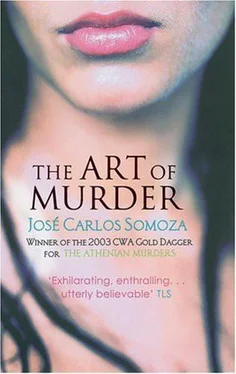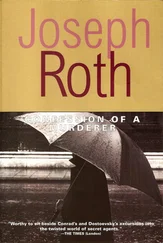Jose Somoza - Art of Murder
Здесь есть возможность читать онлайн «Jose Somoza - Art of Murder» весь текст электронной книги совершенно бесплатно (целиком полную версию без сокращений). В некоторых случаях можно слушать аудио, скачать через торрент в формате fb2 и присутствует краткое содержание. Жанр: Триллер, на английском языке. Описание произведения, (предисловие) а так же отзывы посетителей доступны на портале библиотеки ЛибКат.
- Название:Art of Murder
- Автор:
- Жанр:
- Год:неизвестен
- ISBN:нет данных
- Рейтинг книги:4 / 5. Голосов: 1
-
Избранное:Добавить в избранное
- Отзывы:
-
Ваша оценка:
- 80
- 1
- 2
- 3
- 4
- 5
Art of Murder: краткое содержание, описание и аннотация
Предлагаем к чтению аннотацию, описание, краткое содержание или предисловие (зависит от того, что написал сам автор книги «Art of Murder»). Если вы не нашли необходимую информацию о книге — напишите в комментариях, мы постараемся отыскать её.
Art of Murder — читать онлайн бесплатно полную книгу (весь текст) целиком
Ниже представлен текст книги, разбитый по страницам. Система сохранения места последней прочитанной страницы, позволяет с удобством читать онлайн бесплатно книгу «Art of Murder», без необходимости каждый раз заново искать на чём Вы остановились. Поставьте закладку, и сможете в любой момент перейти на страницу, на которой закончили чтение.
Интервал:
Закладка:
Having met Emma Thorderberg led him to say yes when, a few years later, Jacob Stein called him to offer him the post of security supervisor at the Foundation. Bosch consoled himself thinking that it was not the hefty raise in salary that led him to quit the police force (not just that, at least). To Bosch, protecting works of art was the same as protecting people. In the end, as Hendrickje used to say – things tend to even out.
The third photo was a snapshot of his beloved niece Danielle, his brother's daughter. Roland Bosch, who was five years younger than Lothar, had studied medicine and become an ear, nose and throat specialist. He ran a prosperous private practice in The Hague, but was one of those people who only feels happy doing something out of the ordinary – risky sports, suddenly buying shares, impulse buying and selling, and so on. When looking for a wife he chose a famous and stunningly beautiful German TV actress who he had met in Berlin. He easily overcame the ugliness characteristic of the Bosch family, and was confident his only daughter would inherit her mother's looks. Danielle Bosch was pretty, it was true, but she was also a ten-year-old child, and Lothar felt she did not deserve such a family. Roland and Hannah had brought her up with a magic mirror that rendered her homage every day. The year before they had wanted their little goddess to go into cinema. They took her to various castings, but Danielle was a pretty poor actress, with rather too deep a voice. She was turned down, to her parents' disgust and her uncle's secret joy. Only two months ago, however, things had taken a new and unsuspected turn: Roland had decided to educate Danielle seriously and had sent her to a private school in The Hague. Bosch was surprised at the news, but he was also worried on Danielle's behalf. He wondered how the girl would get on in this atmosphere, so distant from her parents' uncritical adoration. Lothar loved Danielle with a passion only explicable in a childless widower of around fifty: not the Danielle that Roland and Hannah were creating, but the little girl who occasionally shared smiles and thoughts with him. Hendrickje had never met Danielle, but Bosch was sure they would have got on. Hendrickje and Roland were great friends.
According to Lothar Bosch, the world is divided into two categories of people: those who know how to live, and those who protect those who know. People like Hendrickje and his brother Roland belong to the first category; Bosch to the second.
He was staring intently at Danielle's photo, when Nikki Hartel came into his office. 'I think we've got something, Lothar.'
April Wood's office is on the sixth floor of the New Atelier. It is full of artworks. They are flesh-coloured nudes or near-nudes. No artifice, no fascinating colours, nothing complicated. Wood likes abstract body art, where the figures are shown as simple virgin anatomies in uniform colours: always white Caucasians, nearly always female, built like ballet dancers or acrobats. They are very expensive, but she can afford it. And the Foundation allows her to decorate her office as she likes. Almost all the works are by the new British school. By the door is a Jonathan Bergmann called Body Cult which Bosch particularly likes, perhaps because of its beautiful ballet posture. Standing at the far end of the room, legs apart and hands on hips, there is an Alec Storck painted with tanning lotions and sunscreens of different strengths. There are also three Morris Bird originals: a girl painted lunar blue standing on her head by the window, a boy balancing on one leg next to the desk – his yellow buttocks brushing against the telephone cable – and another ochre and fuchsia girl crouching on the floor like a frog about to leap.
Although he was used to this by now, Bosch was always taken aback when he went into the office. 'Yes?' 'April, good news.'
She was pacing up and down, hands behind her back, dressed in a silver-grey tubular dress. (Joan of Arc in her armour, he thought.) She looked like a queen surrounded by naked statues. Her face showed her concern. 'Let's go to the other room,' she said.
This small room was connected to her office by a short, mirror-lined corridor. It had no windows or human ornaments. Miss Wood closed the door so that the works could not hear them, and offered Bosch a seat. She sat opposite him. Bosch handed her the documents Nikki had brought him. There were several laser-printed photos.
'Look at this blonde woman. She was filmed on three different occasions by the video cameras in the entrance to the Vienna MuseumsQuartier in May. Now look at this man. He was filmed four times by the same cameras, on different days from the girl. And now the most incredible part.' He showed her a third sheet of paper with computer graphics. 'The morphometric analysis of their faces shows a high correlation. There's an eighty per cent probability that it is the same person.' 'What about Munich?'
'Here are the results. Three visits by her, two by him, on alternating days, during the second fortnight in May.'
'Perfect. We've got him. He had enough time to get back to Vienna and change into the girl without papers. But it would be even more perfect if we could compare him to the fake Diaz or the fake Weiss
…' 'Surprise.'
Bosch handed her another sheet of paper. As he bent over Miss Wood, he could see how pale her face was beneath the shadow of her fringe. My God, she puts make-up on like a pharaoh, as if she were scared of anyone seeing her without protection, he thought. It was also true that she seemed different since their return from Munich. He guessed that the work did not help, but he wondered whether there was something else as well. His finger trembled as he pointed to the photo: it was of two men, one facing away, the other towards the camera. The one facing the camera was of athletic build, had long hair and wore sunglasses.
"This is taken by the video camera in the Wunderbar hotel. It shows the moment when the fake Weiss arrived at the hotel on Tuesday afternoon to do the Gigli work. The man with his back to the camera is one of our security agents checking his documents. We processed the image at once. The morphometric analyses coincide ninety-eight per cent with the man in Vienna and Munich, and ninety-five per cent with the woman. The possibility of false positives is around fourteen per cent. It's the same person, April, we're almost sure of it.' 'It's incredible.' 'I'm sorry, April, is something wrong?'
Bosch was alarmed that all of a sudden his colleague was sitting staring intently at a fixed point on the wall.
‘I got a call from London’ said Miss Wood. 'My father is worse.'
'Oh, I'm so sorry. A lot worse?' 'Worse.'
Conversations about April Wood's private life tended to be monosyllabic, words uttered succinctly followed by prolonged silences. 'Good', 'bad', 'better' and 'worse' were the preferred options. As a result, all Bosch knew about her were rumours. He had heard that her father had influenced her significantly in a way he did not like to speculate on, and that he was now very ill in a private hospital in London. He also knew that Wood had never married, and that comments about her possible lesbianism were not infrequent. But the previous head of security, Gerhard Weyleb, had told him about her stormy relationship with Hirum Oslo, one of the most important and influential art critics in all Europe. Bosch admitted he only knew Oslo slightly, but even so could not see what possible attraction a woman like April could have found in that skinny, crippled, helpless creature.
Miss Wood was as passionate a mystery as the unexplored ocean bed. When they had first been introduced, Bosch had not liked her at all.
Judging by what had happened with Hendrickje, he surmised that he would end up falling in love with her. Tm really sorry about that, April,' he said.
Читать дальшеИнтервал:
Закладка:
Похожие книги на «Art of Murder»
Представляем Вашему вниманию похожие книги на «Art of Murder» списком для выбора. Мы отобрали схожую по названию и смыслу литературу в надежде предоставить читателям больше вариантов отыскать новые, интересные, ещё непрочитанные произведения.
Обсуждение, отзывы о книге «Art of Murder» и просто собственные мнения читателей. Оставьте ваши комментарии, напишите, что Вы думаете о произведении, его смысле или главных героях. Укажите что конкретно понравилось, а что нет, и почему Вы так считаете.












